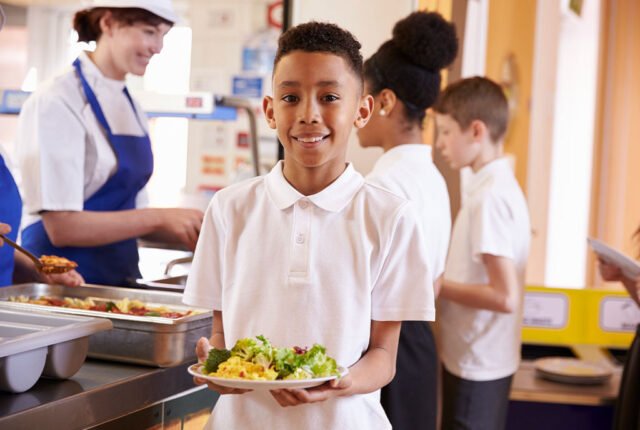
From Wisconsin dairy farmers to the ranchers of the Dakotas, small, local producers face a myriad of challenges that may culminate in them, quite literally, losing the farm. But a unique approach to school lunches that involves using local farms to produce food for children regardless of their families’ economic status may hold the key to their sustainability.
Between higher prices, the rise of big agriculture, and other social and family-related issues, such as finding affordable childcare, farmers are under pressure.
Climate change is only adding to this balancing act, as the weather becomes more unpredictable and new pests emerge. Supply chain vulnerabilities—which garnered national attention during the COVID-19 pandemic when crops were left to rot because suppliers were unable to transport them to consumers who faced empty shelves—add another set of concerns to an already fraught landscape.
While farmers are forced to contend with all these factors, the unavailability of fresh, nutrient-rich food is hurting the nation’s health. A growing body of research suggests that our highly processed diets and poorly designed built environments are doing Americans more harm than good.
Poor Food Options, Poor Environment, Costly Consequences
Ultraprocessed food has been linked to increasing rates of cardiovascular disease, diabetes, depression, obesity, and cancer. However, it is hard to pinpoint why, exactly, these increases are occurring. There isn’t agreement within the research community on whether a single ingredient is behind these increases or if a combination of ingredients is making people sick. Sugar, for instance, has been singled out by scientists and food policies. Excessive intake of trans fat has been linked to heart disease and other cardiovascular issues.
Unfortunately, due to complexities in the relationship between food and health, highly processed foods have been surprisingly difficult to regulate.
Moreover, the packaging of ultraprocessed foods has also been found to play an increasingly detrimental role in health. For example, bisphenol A, an industrial chemical used in the plastic packaging of some ultraprocessed foods, has been linked to an increased risk of cardiometabolic disease and has consequently been banned in some countries. A similar chemical, bisphenol S, was introduced as a replacement. Bisphenol S has endocrine-disrupting properties, which according to the National Institute of Environmental Health Sciences, can interfere with the body’s hormones and has been linked to several serious health issues.
Alarmingly, vulnerable young people are first, and often most, impacted.
Processed foods in school lunches present another barrier to US schoolchildren’s optimal health and nutrition. Though school lunches must follow certain dietary guidelines, school meal nutrition standards do not explicitly prohibit ultraprocessed food. The regular consumption of processed foods, present in many school lunches across the country, is associated with malnutrition, which affects millions of children in the United States.
When it comes to safeguarding our health, it seems as though the answer lies in eating less ultraprocessed food, but the reality is more complicated. Many people lack access to healthy foods either due to cost or access—or both.
In some places, food deserts are also concrete deserts devoid of healthy food and nature more generally. This lack of green spaces has also been linked to negative health outcomes such as poor mental health. Many studies have also shown that reduced exposure to the natural environment increases the risk of early death and an overall decreased quality of life.
The lack of access to healthy foods and nature at the most basic level has an incredibly negative impact on overall health and wellbeing. Alarmingly, vulnerable young people are first, and often most, impacted.
The Importance of Universal School Meals
The larger issue for many children is not if they will have a healthy meal but if they will have a meal at all. Across the country, roughly 43 million Americans are faced with food insecurity. That breaks down to one in 10 people going hungry in the world’s wealthiest nation, including around 11 million children.
The evidence base for child hunger in the United States stretches at least as far back as a 1905 publication of a survey exposing food insecurity as a widespread issue. This realization, paired with the advocacy of women’s rights groups at the time, saw the advent of the first free or reduced-price lunch programs in cities like Boston and New York. These programs had such a positive impact on children that the federal government created its own program during the Great Depression.
Sign up for our free newsletters
Subscribe to NPQ's newsletters to have our top stories delivered directly to your inbox.
By signing up, you agree to our privacy policy and terms of use, and to receive messages from NPQ and our partners.
The larger issue for many children is not if they will have a healthy meal but if they will have a meal at all.
Similarly, universal school lunch programs proved invaluable during the COVID-19 pandemic when pandemic relief programs swept aside much of the paperwork that had previously been required to access breakfast and lunch programs. The expansion of school lunch programs benefited families regardless of income bracket. And, as researchers at the Urban Institute have noted, the benefits go beyond health and nutrition: “Schools that have universal school meals tend to have higher test scores, fewer disciplinary problems, less bullying, [and] less stigma.”
However, even as inflation continues to rise, further limiting many families’ access to healthy food, the federal government has cut the allowance for universal access to the school lunch program. Now, 93.6 percent of school districts are reporting increasing levels of debt from families who are ineligible for subsidies or didn’t know they should apply for them. These debts have consequences: families’ lunch debt may go to collections, and school staff have publicly shamed students for not being able to buy their school lunch. For instance, in 2016, school staff at an Alabama elementary school stamped the hands of eight-year-olds with the words, “I need lunch money.” In other cases, children simply go hungry.
Community advocates and nonprofits have been fighting for state-led responses to child hunger, like Hunger Day in Minnesota, which was organized by Hunger Solutions and pressed legislators to address hunger in the community. This effort paid off when Minnesota governor Tim Walz signed a bill that allocated state funds for free universal lunch and breakfast for all students in the state. Minnesota is not alone in using universal school meals to improve overall health. Other states like California, Colorado, and Maine have passed similar legislation and another 24 states are considering it. Yet while the Minnesota school lunch program has proven to be very popular, it has also proven to be more expensive than expected.
School gardens combined with school lunch programs where children eat what they grow also carry positive environmental impacts.
Using School Gardens to Support the Universal School Meals Program
Though increasing federal support for universal school lunch programs is perhaps the most obvious solution, new and innovative ways to fund programs could address multiple concerns at the same time. One way is to expand or reintroduce school garden programs which are eligible for USDA grants.
The introduction of school gardens has a remarkable impact on the students who have access to them. Gardeneers, an organization that supports school garden and farm programs for schoolchildren in Chicago, saw increased healthy eating among students as well as improved social and emotional capabilities. Additionally, school gardens have been shown to improve children’s eating behavior by improving their dietary self-efficacy, nutrition knowledge, vegetable preference, and vegetable consumption.
School gardens combined with school lunch programs where children eat what they grow also carry positive environmental impacts. By shifting school lunches away from multinational corporations, communities can reduce the environmental costs of food transport and packaging. Of course, school gardens are not enough to fully supply meals to all students, but they offer a good place to start.
Buying Food from Local Farmers
Another approach that could be easily combined with school gardens would be to source food directly from local farmers. In Barons: Money, Power, and the Corruption of America’s Food Industry, Austin Frerick notes how the reliable contracts offered by schools would provide a lifeline for small local producers battered by monopoly markets for their products. Even farmers in more specialized markets, like bison farmers Kurt and Chris Wensel of Colfax, WI, “think it would be great to sell to the community around here including the local school districts. After all, good food is important.”
And while Wisconsin is not one of the states to have adopted universal school meals, it is ahead of the curve when it comes to connecting farmers and schools through their farm-to-school programs. The Tides Foundation also provides a program that seeks to connect farmers and schools. Meanwhile, the USDA offers a variety of grants for both school gardens and farm-to-school programs.
These efforts have been slow to gain traction despite their promise for both human health and climate change mitigation. Industrial food systems, including packaging and global food transportation, are significant contributors to climate change. A Global Alliance for the Future of Food report found that the majority of fossil fuel consumption in our food system is linked not to food production but to the “processing and packaging stage (42 percent), and in retail consumption and waste (38 percent).”
The adoption of universal school meals and farm-to-school programs creates an opportunity to build healthier, more sustainable places for children, farmers, and their broader communities. By using locally grown and farmed food, from both school gardens and local farms, schools can also improve the nutrition and therefore the health and wellbeing of schoolchildren throughout the United States. In the midst of the current challenges posed by the climate crisis, food insecurity, and malnutrition, these investments in America’s children and our local food systems could set America on a new path where health, wellness, and prosperity are more equitably distributed.











